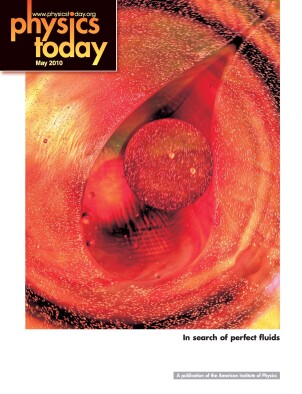More light on ruby laser’s history
DOI: 10.1063/1.4797323
The account of ruby laser activities at Bell Labs in 1960 was fascinating. During the same period, the group working under Charles Townes at Columbia University’s Radiation Lab (CRL) was pursuing a different, and ultimately failed, track to the first laser.
Herman Cummins and I were the graduate students assigned to make the IR continuous-wave potassium laser and, later, the cesium vapor laser outlined in the 1958 paper Townes wrote with Arthur Schawlow. 1 Townes brought in Oliver Heavens, a thin-film expert from Royal Holloway College in the UK, to help us produce our own reflecting films. We began in 1958, but we had difficulty pumping potassium with a high-pressure mercury lamp at 404.7 nm, so we turned to cesium vapor pumped with a helium discharge tube at 388.8 nm. We used an elliptical reflecting cylinder and tried sapphire tubing and sapphire windows to avoid cesium darkening in glass.
By June 1960 we had measured gain but no laser oscillation. Heavens attended the June spectroscopy meeting in Rochester, New York, and gave an overly optimistic progress report of the cesium work. We later learned that Malcolm Stitch from Hughes Research Laboratories was at the meeting, and thus the Hughes group heard that the Columbia group was “about to succeed.” That probably helped stampede Maiman into the now famous press conference. But the cesium laser never did work at Columbia.
I learned of the Maiman ruby laser through a telephone call from Walter Sullivan, then science editor of the New York Times. He often called Townes, who that day was in Washington, DC, so I took the call. Depressed, I thought, “There goes my PhD thesis.” Townes called me the next day, and I was given an open account to spend what it took to make a ruby laser. Bill Rose at CRL had a pink ruby boule for use as a maser amplifier in his radio telescope. We cut and polished a slice for my laser and evaporated silver reflective films on the rod ends. The lab bought the flashtubes, storage capacitors, and power supply. My laser worked in about two months, just before Labor Day.
We published two papers’ worth of work, enough for a thesis. 2,3 Then Sven Hartmann, Norm Kurnit, and I did the first experiment that observed photon echoes in ruby. 4
In retrospect, Townes made the correct decision to abandon the cesium laser project.
References
1. A. L. Schawlow, C. H. Townes, Phys. Rev. 112, 1940 (1958).
2. I. D. Abella, H. Z. Cummins, J. Appl. Phys. 32, 1177 (1961).
3. I. D. Abella, Phys. Rev. Lett. 9, 453 (1962).
4. N. A. Kurnit, I. D. Abella, S. R. Hartmann, Phys. Rev. Lett. 13, 567 (1964).
More about the Authors
Isaac D. Abella. (asea@uchicago.edu)University of Chicago, Chicago, Illinois, US .
